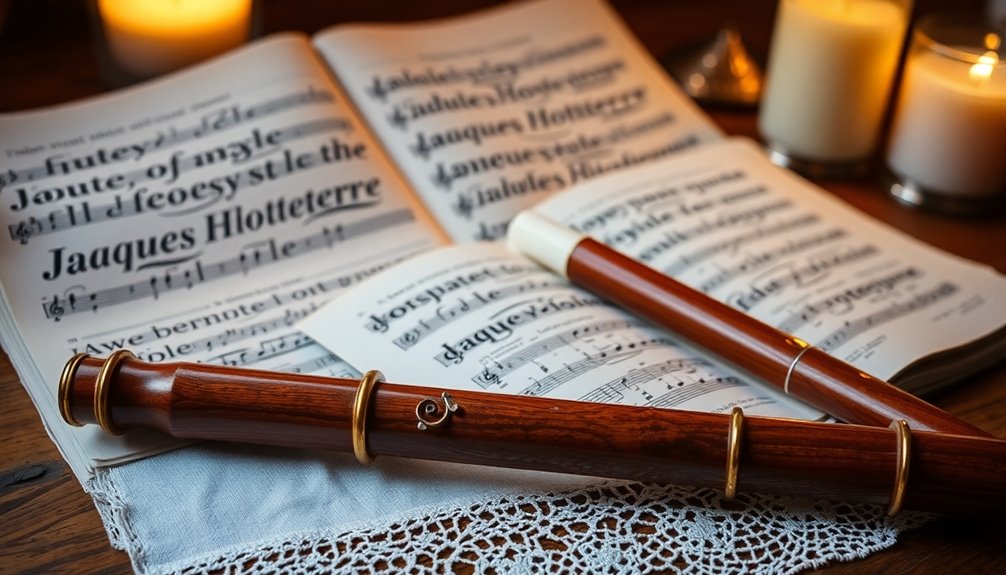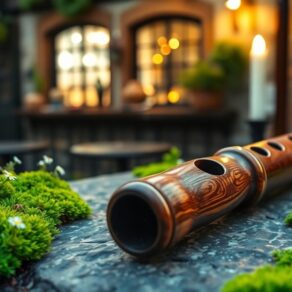In the Baroque era, renowned flutists like Jacques Hotteterre, Johann Joachim Quantz, and Michel Blavet revolutionized the traverso's performance and techniques. Hotteterre's treatise emphasized expressive playing, while Quantz focused on breath control and dynamic expression, influencing countless musicians. Blavet showcased agility and ornamentation, setting new standards for flute artistry. Giovanni Battista Venturi and Pierre-Gabriel Buffardin further refined the instrument's capabilities through innovative compositions and virtuosic techniques. Their collective mastery not only transformed the traverso but also shaped the evolution of flute music. Explore these remarkable figures to uncover their profound impact on the Baroque music landscape.
Key Takeaways
- Jacques Hotteterre pioneered Baroque flute design and technique, focusing on expressive playing and ensemble roles in his work "Principes de la Flûte Traversière."
- Johann Joachim Quantz emphasized breath control and dynamic expression, documenting his insights in "On Playing the Flute" and tutoring influential students.
- Michel Blavet contributed to flute pedagogy with fluid ornamentation and intricate repertoire, enhancing the expressive capabilities of the Baroque flute.
- Giovanni Battista Venturi showcased agility and lyricism, introducing diverse articulations and dynamic contrasts that enriched Baroque flute performance.
- Pierre-Gabriel Buffardin's technical mastery and innovative compositions expanded the flute's capabilities, blending traditional Baroque elements with modern appeal in his works.
Jacques Hotteterre

Recognized as a pioneering figure in the development of the Baroque flute, Jacques Hotteterre greatly shaped the landscape of woodwind performance in the early 18th century. His innovations in flute design and technique, particularly with the traverso, set a standard that many flutists still aspire to today.
You'll find that Hotteterre's influence extended beyond mere instrument construction; he revolutionized performance practices that emphasized expressive playing and technical proficiency.
By focusing on the traverso technique, Hotteterre introduced a refined approach to articulation, breath control, and finger dexterity. His treatises, particularly "Principes de la Flûte Traversière," offer invaluable insights into the nuances of Baroque style, encouraging flutists to embrace ornamentation and dynamic contrasts.
As you explore his teachings, you'll notice a strong emphasis on the importance of phrasing and musicality, aspects that are essential for any aspiring flutist seeking to connect with their audience.
Moreover, Hotteterre's influence on ensemble playing can't be overstated. He championed the integration of the traverso within orchestral settings, advocating for the flute's role in a more collaborative music-making process.
This shift not only elevated the flute's status but also enriched the texture of Baroque music. Studying Hotteterre's contributions will deepen your understanding of the traverso and inspire you to explore the emotional depths of the Baroque repertoire, solidifying your place in this rich musical tradition. Additionally, his emphasis on technical skills plays a vital role in the foundation laid by methods like the Rubank Elementary Method, which focus on developing essential flute techniques.
Johann Joachim Quantz

Examining the contributions of Johann Joachim Quantz reveals a pivotal figure in the evolution of flute performance during the Baroque era. As a virtuoso flutist and prolific composer, Quantz's techniques greatly shaped the way the traverso was played. His emphasis on breath control, finger agility, and dynamic expression allowed flutists to explore a wider range of musical nuances.
You might find it intriguing that Quantz meticulously documented his insights in "On Playing the Flute," a seminal treatise that not only outlined his playing methods but also addressed the aesthetics of music during his time.
Quantz's techniques extended beyond mere performance; he was also an innovator in instrument design, advocating for improvements that enhanced the flute's tonal quality and playability. This quest for perfection resonates with flutists today, as many still reference his principles in their practice. His influence is palpable in the way contemporary musicians approach the instrument, reflecting a legacy that transcends centuries.
Moreover, Quantz's legacy isn't confined to his own performances or treatises. He tutored numerous students, including Frederick the Great, ensuring that his methods and philosophies permeated the musical landscape of his era. Additionally, his focus on breath support laid the groundwork for future flutists to achieve greater expressiveness and control in their playing.
Michel Blavet

While Michel Blavet mightn't be as widely known as Johann Joachim Quantz, his contributions to flute music during the Baroque era are equally significant. Blavet, a French flutist and composer, emerged as a pivotal figure in the development of the traverso, the wooden flute prevalent in this period. His technique was innovative, showcasing a level of expressiveness and virtuosic skill that set new standards for flutists of his time.
Blavet's technique emphasized fluidity and agility, allowing for intricate ornamentation and dynamic contrasts that captivated audiences. He often employed a unique breath control that enabled seamless phrasing, a characteristic that defined his performance style. This mastery not only elevated his own compositions but also inspired contemporaries and later generations of flutists. Additionally, his approach to breath control laid the groundwork for future flutists to develop their own techniques for sustained notes and musical expression.
Blavet's influence extended beyond his compositions, as he played an important role in the evolution of flute pedagogy. His works, particularly his sonatas and concertos, became essential repertoire for students and professionals alike, establishing a benchmark for flute playing in the 18th century.
Furthermore, his collaborations with other composers and musicians enriched the musical landscape of the era, fostering a sense of community among flutists.
Carl Philipp Emanuel Bach

Carl Philipp Emanuel Bach stands out as a pivotal figure in the history of flute music during the Baroque era, particularly through his innovative approach to composition and performance. As the second son of J.S. Bach, C.P.E. Bach broke away from the strict forms of his father's style, embracing a more expressive and free-flowing musical language.
You'll find that C.P.E. Bach's innovations are evident in his flute sonatas and concertos, where he skillfully blends technical demands with profound emotional expression.
One of the hallmarks of Bach's flute works is their ability to convey a wide range of feelings, from joy to melancholy, often reflecting the Sturm und Drang movement of the time. This emotional depth invites you to connect with the music on a personal level, allowing you to experience the nuances of human sentiment.
His use of surprising harmonic progressions and dynamic contrasts engages the performer and listener alike, creating an immersive experience.
Moreover, C.P.E. Bach's emphasis on the soloistic capabilities of the flute established it as a prominent instrument in the chamber music repertoire. This shift not only elevated the flute's status but also inspired future composers to explore its expressive potential.
As you investigate his works, you'll appreciate how C.P.E. Bach not only paved the way for later flutists but also forged a deeper connection between music and emotion, making his contributions both significant and enduring in the world of Baroque music. Furthermore, his exploration of flute materials contributed to the development of distinct tonal qualities that enhanced the expressive capabilities of the instrument.
Giovanni Battista Venturi

Giovanni Battista Venturi emerges as a significant figure in the domain of Baroque flute music, known for his contributions that highlight the instrument's versatility and expressive depth. You'll find that his innovative techniques and stylistic approaches not only advanced the use of the traverso but also laid the groundwork for future generations of flutists.
Venturi's techniques were characterized by a unique blend of agility and lyricism, allowing him to navigate complex passages with ease. He often employed a variety of articulations and dynamic contrasts, which contributed to the emotive quality of his performances. His works reflect a keen understanding of Baroque innovations, as he experimented with ornamentation and phrasing, pushing the boundaries of what was possible on the flute.
Here's a closer look at some of his notable contributions:
| Technique | Description |
|---|---|
| Extended Range | Venturi expanded the flute's range, enhancing its melodic possibilities. |
| Articulation Variations | He introduced diverse articulations, enriching expressiveness in performances. |
| Improvisational Skills | His ability to improvise showcased the flute's adaptability across genres. |
| Ornamentation | Venturi's use of elaborate ornaments added a distinctive flair to his pieces. |
| Dynamic Contrast | He skillfully manipulated dynamics, creating emotional depth in his music. |
Through these advancements, Venturi not only shaped the trajectory of flute music but also inspired a sense of community among musicians, encouraging them to explore and innovate within the Baroque tradition. His mastery of the instrument exemplifies the importance of breath control and finger agility in achieving expressive performances.
Pierre-Gabriel Buffardin

Pierre-Gabriel Buffardin stands out as a crucial figure in the Baroque flute repertoire, renowned for his technical mastery and innovative compositions. You can see his influence on the traverso, the wooden flute that defined the era. Buffardin's techniques were groundbreaking, incorporating intricate fingerings and expressive dynamics that expanded the instrument's capabilities. His approach to breathing and articulation set a new standard, allowing flutists to convey a broader emotional range.
Buffardin's compositions, too, reflect his deep understanding of the flute's potential. His concertos and sonatas, characterized by their lyrical melodies and intricate counterpoint, invite performers to explore both technical prowess and interpretive depth. You'll find that his works often showcase virtuosic passages that challenge even the most skilled flutists, pushing musical boundaries while maintaining lyrical beauty.
What's remarkable about Buffardin is how he blended traditional Baroque elements with his unique voice, creating a distinctive style that resonates with audiences today. His use of ornamentation, for instance, enhances the expressiveness of his melodies, inviting listeners into a rich tapestry of sound.
In studying Buffardin, you'll discover not just a flutist, but a composer who contributed considerably to the evolution of flute music. His legacy is felt in the way modern flutists approach their craft, ensuring that his techniques and compositions remain a crucial part of the repertoire. This dedication to craftsmanship mirrors the technical skills development found in the realm of flute performance.
Embracing his work not only enriches your understanding of the Baroque era but also connects you to a community of passionate musicians who share your appreciation for this timeless art form.
Frequently Asked Questions
What Materials Were Commonly Used to Make Baroque Flutes?
When exploring the materials used to make Baroque flutes, you'll discover that wood selection was paramount.
Craftsmen typically favored dense woods like boxwood or grenadilla for their tonal qualities.
While some flutes were made entirely of wood, metal use began to emerge, particularly in the form of silver or brass keys, enhancing playability and range.
This blend of materials reflects the evolution of craftsmanship during the Baroque period, shaping the instrument's character and sound.
How Did the Traverso Differ From Modern Flutes?
Imagine stepping into a world where music flows like a gentle stream, each note carrying the essence of its time.
The traverso differs from modern flutes mainly in its construction and sound differences. Crafted from wood, the traverso produces a warmer, more mellow tone, while modern flutes, often made of metal, yield a brighter, sharper sound.
This contrast not only affects playing techniques but also shapes the listener's emotional experience, creating a unique musical journey.
What Techniques Did Baroque Flutists Use to Enhance Their Performance?
Baroque flutists employed various techniques to enhance their performance, focusing on breath control and finger technique.
You'd notice that they mastered breath control to create dynamic phrasing, allowing for expressive nuances.
Their finger technique involved precise fingerings and rapid articulation, enabling them to execute complex passages with agility.
Who Were Some Lesser-Known Flutists of the Baroque Era?
You might think every Baroque flutist was a household name, but there were countless unknown flutists whose hidden talents deserve recognition.
Musicians like Johann George Tromlitz and Pierre-Gabriel Buffardin contributed considerably to the flute repertoire, yet often remain in the shadows.
They pushed the boundaries of technique and expression, enriching the music scene.
Exploring their work reveals a treasure trove of artistry and innovation that deepens your appreciation for the Baroque flute's legacy.
What Role Did Improvisation Play in Baroque Flute Music?
Improvisation played an essential role in Baroque flute music, allowing you to explore personal musical expression.
You'd use improvisation techniques to embellish melodies, adding flourishes and variations that showcased your creativity. This practice wasn't merely decorative; it reflected the era's emphasis on individual artistry within a structured framework.
Conclusion
In exploring the contributions of Baroque flutists like Hotteterre and Quantz, it's clear these masters shaped the traverso's legacy, much like modern-day virtuosos redefine the flute with each performance. Their innovative techniques and compositions not only elevated the instrument's status but also paved the way for future generations. Imagine them amidst a bustling café, exchanging ideas over lattes, their melodies intertwining like the very threads of history that connect us to their extraordinary artistry today.






